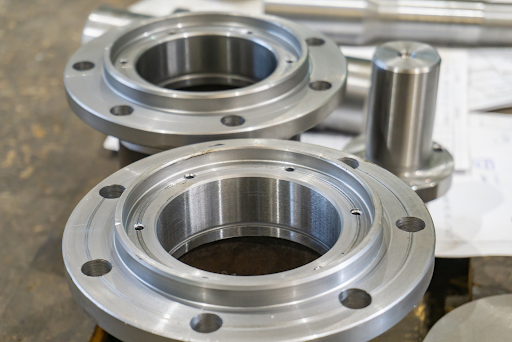Flanges serve as important components in piping systems, connecting pipes, valves, and equipment while allowing for easy maintenance and repairs. Understanding flange dimensions is essential for ensuring secure connections. This article provides an overview of flange dimensions, focusing on two prominent standards: ANSI/ASME B16.5 Class 150 Forged Flanges and ANSI/AWWA standards.
Image Source: Texas Flange
Key Flange Dimensions:
- Nominal Pipe Size (NPS): This tells us the size of the pipe the flange connects to, measured in inches.
- Flange Diameter (D): It’s the outer dimension of the flange, determining its size and compatibility.
- Inside Diameter (ID): This is the opening in the flange where the pipe goes. It’s vital for a proper fit and smooth flow.
- Outside Diameter (OD): The total outer size of the flange, including bolt holes.
- Bolt Hole Diameter (BHD): The size of the holes used to attach the flange to other components.
- Bolt Circle Diameter (BCD): The measurement of the circle formed by the bolt holes.
- Flange Thickness (T): How thick the flange material is, varying based on its type and pressure rating.
- Raised Face (RF) or Flat Face (FF): Some flanges have raised faces for better sealing, while others are flat.
- Flange Rating or Pressure Class: Indicates the maximum pressure the flange can handle safely.
- Flange Standards: Flange dimensions follow industry standards, ensuring consistency across different systems.
ANSI/ASME B16.5 Class 150 Forged Flanges
Image Source: Texas Flange
The ANSI/ASME B16.5 standard specifies flange dimensions for various types, including weld neck, slip-on, socket weld, threaded, lap joint, and blind flanges. These flanges are designed for pipes ranging from 1/2″ to 24″ and are categorized into classes ranging from 150 to 2500.
ANSI/AWWA Standards Flanges
These standards apply to flanges designed for water service with working pressures of 250 psi and above. It’s important not to confuse them with ANSI B16.1 Class 125 flanges. The critical dimensions are based on bolt circle and bolt hole specifications from ANSI B16.1 Class 125.
Image Source: Texas Flange
Some key points:
Working Pressure: 250 psi (for water service)
Flange Facing: Plain faced and finished smooth or with shallow serrations
Back Facing: Flanges may be back faced or spot faced
Drilling: Drilling can be rotated when required
Taps and Tap Locations: Taps are made directly into the wall of the flanged fitting, but exact tap locations may vary
Application and Selection
When it comes to picking flanges for a system, you can’t just grab any. You need to think about things like pipe size, pressure, temperature, and what’s flowing through them. Different industries have unique needs. For instance, the oil and gas industry deals with high-pressure and corrosive substances, while the food industry requires hygiene and specific materials. Always stick to industry standards for safety.
For specific dimensions and measurements, refer to the website like Texas Flange.
FAQs – Your Questions Answered
Q1: What’s the point of flanges in a piping system?
A: Flanges serve as connectors, allowing pipes, valves, and equipment to be securely joined together. They make assembly, disassembly, and maintenance easier.
Q2: Why is Nominal Pipe Size (NPS) important in flange dimensions?
A: NPS determines the size of the pipe to which the flange is attached. It’s critical for ensuring compatibility and proper sizing of flanges in a piping system.
Q3: How does flange thickness (T) vary based on flange type and pressure rating?
A: Flange thickness varies based on the structural and pressure requirements of different applications. High-pressure systems often require thicker flanges for strength.
Q4: What’s the difference between a raised face (RF) and a flat face (FF) flange?
A: A raised face creates a tighter seal when compressed, suitable for applications where leak prevention is crucial. Flat faces are used when gasket compression isn’t needed.
Q5: How do I choose the right flange for my specific application?
A: Consider factors like pipe size, pressure rating, temperature, fluid type, and industry-specific requirements when selecting flanges. Adhere to industry standards for safety.
Q6: Can flange dimensions vary between different countries or regions?
A: Yes, flange dimensions can vary depending on the standards adopted in different countries or regions. Common standards include ANSI/ASME, DIN, and JIS, each with its set of dimensions.
Conclusion
Understanding flange dimensions is essential for selecting the right flanges for your piping systems. Whether you’re working with ANSI/ASME B16.5 Class 150 Forged Flanges or ANSI/AWWA standards, accurate measurements ensure a reliable and leak-free connection.
This article provides a foundational understanding of flange dimensions, but it’s important to consult the appropriate standards and specifications for precise measurements when working on piping projects.



